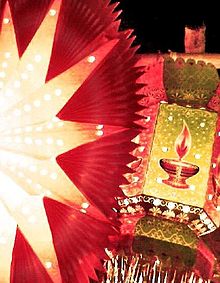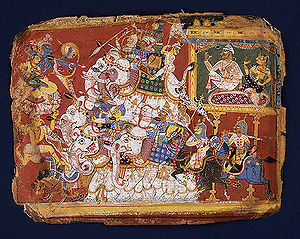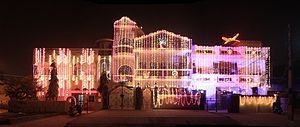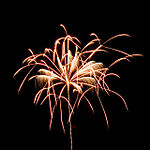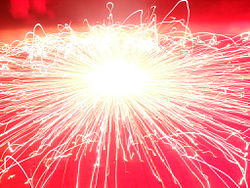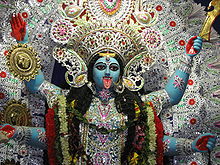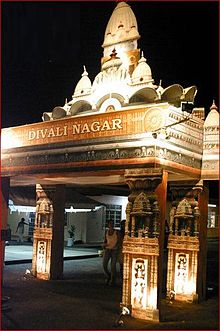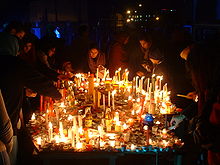- Diwali
-
Diwali (Dipawali) 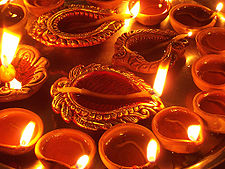
Diyas (oil lamp) during DiwaliAlso called Translation: Row of Lights; Diwali, Festival of Lights Observed by Hindus, Sikhs, Jains, Buddhists Type Religious, India, Nepal, Sri Lanka, Myanmar, Mauritius, Guyana, Trinidad & Tobago, Surinam, Malaysia, Singapore, and Fiji (National holiday in these countries) Significance Celebration of the victory of good over evil; the uplifting of spiritual darkness Date Decided by the luni-solar Hindu calendar 2010 date 5 November 2011 date 26 October 2012 date 13 November Celebrations Decorating homes with lights, Fireworks, distributing sweets and gifts Observances Prayers, Religious rituals (see puja, prashad) Diwali (also spelled Devali in certain regions) or Deepavali[note 1], popularly known as the "festival of lights," is a festival celebrated between mid-October and mid-November for different reasons.[1] For Hindus, Diwali is one of the most important festivals of the year and is celebrated in families by performing traditional activities together in their homes. For Jains, Diwali marks the attainment of moksha or nirvana by Mahavira in 527 BC.[2][3]
Diwali is an official holiday in India,[4] Nepal, Sri Lanka, Myanmar, Mauritius, Guyana, Trinidad & Tobago, Suriname, Malaysia, Singapore,[5] and Fiji.[6]
The name "Diwali" is a contraction of "Deepavali" (Sanskrit: दीपावली Dīpāvalī), which translates into "row of lamps".[7] Diwali involves the lighting of small clay lamps (diyas or dīpas) in Sanskrit: दीप) filled with oil to signify the triumph of good over evil.[8] These lamps are kept on during the night and one's house is cleaned, both done in order to make the goddess Lakshmi feel welcome.[9] Firecrackers are burst in order to drive away evil spirits.[10][11][12] During Diwali, all the celebrants wear new clothes and share sweets and snacks with family members and friends.
The festival starts with Dhanteras on which most Indian business communities begin their financial year. The second day of the festival, Naraka Chaturdasi, marks the vanquishing of the demon Naraka by Lord Krishna and his wife Satyabhama. Amavasya, the third day of Diwali, marks the worship of Lakshmi, the goddess of wealth in her most benevolent mood, fulfilling the wishes of her devotees. Amavasya also tells the story of Lord Vishnu, who in his dwarf incarnation vanquished the Bali, and banished him to Patala. It is on the fourth day of Diwali, Kartika Shudda Padyami, that Bali went to patala and took the reins of his new kingdom in there. The fifth day is referred to as Yama Dvitiya (also called Bhai Dooj), and on this day sisters invite their brothers to their homes.
Contents
Dates
Diwali falls on the one new moon night (Amavasya) between mid-October and mid-November. This year it was on 26th October 2011. Diwali is celebrated for five days according to the lunisolar Hindu Calendar. It begins in late Ashvin (between September and October) and ends in early Kartika (between October and November). The days in Ashvin are in the Krishna Paksha ("dark fortnight") of that month, while the days in Kartik are in its Shukla Paksha ("bright fortnight"). The first day is Dhan Teras. The last day is Yama Dvitiya, which signifies the second day of the light half of Kartika. Each day of Diwali marks one celebration of the six principal stories associated with the festival.[13]
Hindus have several significant events associated with Diwali:
- The return of Rama after 14 years of Vanvas (banishment). To welcome his return, diyas (ghee lamps) were lit in rows of 20.
- The killing of Narakasura: Celebrated as Naraka Chaturdashi, one day before Diwali, it commemorates the killing of the evil demon Narakasura, who wreaked havoc. Krishna's wife Satyabhama killed Narakasura during the Dwapara yuga. In another version of the belief, the demon was killed by Krishna or Krishna provoked his wife Satyabhama to kill Narshna, defeating Indra.
- Govardhan Puja is celebrated the day after Diwali and is the day Krishna defeated Indra, the deity of thunder and rain. According to the story, Krishna saw preparations for an annual offering to Lord Indra and asked his father Nanda about it. He debated with the villagers about what their 'dharma' truly was. They were farmers, they should do their duty and concentrate on farming and protection of their cattle. He said that all human beings should do their 'karma' to the best of their ability and not pray for natural phenomenon. The villagers were convinced by Krishna, and did not proceed with the special puja (prayer). Indra was then angered, and flooded the village. Krishna lifted Mount Govardhan and held it up to protect the people and cattle from the rain. Indra finally accepted defeat and recognized Krishna as supreme. Although this aspect of Krishna's life is sometimes ignored[citation needed] it sets up the basis of the 'karma' philosophy later detailed in the Bhagavat Gita.
Other events associated with Diwali include:
- Return of Pandavas after 12 years of Vanvas and one year of agyatavas (living incognito).
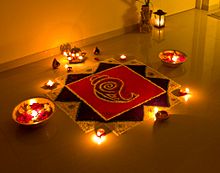 Rangoli, decorations made from coloured powder, is popular during Diwali
Rangoli, decorations made from coloured powder, is popular during Diwali
Diwali celebrations are spread over five days, from Dhanteras to Bhaiduj. In some places like Maharashtra it starts with Vasu Baras.[14] All the days except Diwali are named according to their designation in the Hindu calendar. The days are:
- Govatsa Dwadashi or Vasu Baras (27 Ashvin or 12 Krishna Paksha Ashvin): Go means cow and vatsa means calf. Dwadashi or Baras means the 12th day. On this day the cow and calf are worshiped. The story associated with this day is that of King Prithu, son of the tyrant King Vena. Due to the ill rule of Vena, there was a terrible famine and earth stopped being fruitful. Prithu chased the earth, who is usually represented as cow, and ‘milked’ her, meaning that he brought prosperity to the land.
- Dhanatrayodashi or Dhan teras or Dhanwantari Triodasi[15] (28 Ashvin or 13 Krishna Paksha Ashvin): Dhana means wealth and Trayodashi means 13th day. This day falls on the 13th day of the second half of the lunar month. It is considered an auspicious day for buying utensils and gold, hence the name ‘Dhana’. This day is regarded as the Jayanti (Birth Anniversary) of God Dhanvantari, the Physician of Gods, who came out during Samudra manthan, the churning of the great ocean by the gods and the demons.
- Naraka Chaturdashi (29 Ashvin or 14 Krishna Paksha Ashvin): Chaturdashi is the 14th day This was the day on which the demon Narakasura was killed by Krishna – an incarnation of Vishnu. It signifies the victory of good over evil and light over darkness (Gujarati: Kali Chaudas, Rajasthan : Roop Chaudas). In southern India, this is the actual day of festivities. Hindus wake up before dawn, have a fragrant oil bath and dress in new clothes. They light small lamps all around the house and draw elaborate kolams /rangolis outside their homes. They perform a special puja with offerings to Krishna or Vishnu, as he liberated the world from the demon Narakasura on this day. It is believed that taking a bath before sunrise, when the stars are still visible in the sky is equivalent to taking a bath in the holy Ganges. After the puja, children burst firecrackers heralding the defeat of the demon. As this is a day of rejoicing, many will have very elaborate breakfasts and lunches and meet family and friends.
- Lakshmi Puja (30 Ashvin or 15 Krishna Paksha Ashvin): Lakshmi Puja marks the most important day of Diwali celebrations in North India. Hindu homes worship Lakshmi, the goddess of wealth, and Ganesh, the God of auspicious beginnings, and then light lamps in the streets and homes to welcome prosperity and well-being.
- Bali Pratipada and Govardhan Puja (1 Kartika or 1 Shukla Paksha Kartika) : In North India, this day is celebrated as Govardhan Puja, also called Annakoot, and is celebrated as the day Krishna – an incarnation of god Vishnu – defeated Indra and by the lifting of Govardhana hill to save his kinsmen and cattle from rain and floods. For Annakoot, large quantities of food are decorated symbolizing the Govardhan hill lifted by Krishna. In Maharashtra, Tamil Nadu and Karnataka, it is celebrated as Bali-Pratipada or Bali Padyami. The day commemorates the victory of Vishnu in his dwarf form Vamana over the demon-king Bali, who was pushed into the patala. In Maharashtra, it is called as Padava or Nava Diwas (new day). Men present gifts to their wives on this day. It is celebrated as the first day of the Vikram Samvat calender, in Gujarat.
- Yama Dwitiya or Bhaiduj (also Bhayyaduj, Bhaubeej or Bhayitika) (2 Kartika or 2 Shukla Paksha Kartika): on this day, brothers and sisters meet to express love and affection for each other (Gujarati: Bhai Bij, Bengali: Bhai Phota). It is based on a story when Yama, lord of Death, visited his sister Yami (the river Yamuna). Yami welcomed Yama with an Aarti and they had a feast together. Yama gave a gift to Yami while leaving as a token of his appreciation. So, the day is also called 'YAMA DWITIYA'. Brothers visit their sisters’ place on this day and usually have a meal there, and also give gifts to their sisters.
Lakshmi Puja
Main article: Lakshmi PujaDiwali marks the end of the harvest season in most of India. Farmers give thanks for the bounty of the year gone by, and pray for a good harvest for the year to come. Traditionally this marked the closing of accounts for businesses dependent on the agrarian cycle, and is the last major celebration before winter. Lakshmi symbolizes wealth and prosperity, and her blessings are invoked for a good year ahead.
There are two legends that associate the worship of Lakshmi on this day. According to the first legend, on this day, Lakshmi emerged from Kshira Sagar, the Ocean of Milk, during the great churning of the oceans, Samudra manthan. The second legend (more popular in western India) relates to the Vamana avatar of the big three Vishnu, the incarnation he assumed to kill the demon king Bali. On this day, Vishnu came back to his abode the Vaikuntha; so those who worship Lakshmi receive the benefit of her benevolent mood, and are blessed with mental, physical and material well-being.[16]
As per spiritual references, on this day "Lakshmi-panchayatan" enters the Universe. Vishnu, Indra, Kubera, Gajendra and Lakshmi are elements of this "panchayatan" (a group of five). The tasks of these elements are:
- Lakshmi: Divine Energy (Shakti) which provides energy to all the above activities.
- Vishnu: Happiness (happiness and satisfaction)
- Kubera: Wealth (generosity; one who shares wealth)
- Indra: Opulence (satisfaction due to wealth)
- Gajendra: Carries the wealth
Diwali greetings in some major Indian languages
- Subha Dipawali ko mangalmaya subha kaamanaa (शुभ दिपावली को मंगलमय शुभ-कामना): Greeting in Nepali
- Diwali ki Shubhkamnayein (दिवाली की शुभकामनाएं): Greeting in Hindi
- Diwali Mubarak (દીવાળી મુબારક): Greeting in Gujarati
- Tuhanu diwali diyan boht boht vadhaiyan hon (ਤੁਹਾਨੂੰ ਦਿਵਾਲੀ ਦੀਆਂ ਬਹੁਤ ਬਹੁਤ ਵਧਾਈਆਂ ਹੋਣ ): Greeting in Punjabi
- Deepavali Nalvaazhtukkal (தீபாவளி நல்வாழ்த்துக்கள்) :Greeting in Tamil
- Deepavali Aashamsagal ( ദീപാവലി ആശംസകള് ): Greeting in Malayalam.
- Deepavali Habbada Shubhashayagalu (ದೀಪಾವಳಿ ಹಬ್ಬದ ಶುಭಾಷಯಗಳು): Greeting in Kannada
- Deepavali Shubhakankshalu (దీపావళి శుభాకా౦క్షలు) :Greeting in Telugu
- Shubh Diwali/ Diwalichya hardik Shubhechha (शुभ दिवाली /दिवाळीच्या हार्दिक शुभेच्छा ): Greeting in Marathi
- Subho Diwalir Preeti O Subeccha :Greeting in Bengali
- "Happy Diwali!" :Greeting in English language
- Diwali mubarak ho:Greeting in Hindi(bundelkhand) language
Spiritual Significance
While Diwali is popularly known as the "festival of lights", the most significant spiritual meaning is "the awareness of the inner light". Central to Hindu philosophy is the assertion that there is something beyond the physical body and mind which is pure, infinite, and eternal, called the Atman. The celebration of Diwali as the "victory of good over evil", refers to the light of higher knowledge dispelling all ignorance, the ignorance that masks one's true nature, not as the body, but as the unchanging, infinite, immanent and transcendent reality. With this awakening comes compassion and the awareness of the oneness of all things (higher knowledge). This brings anand (joy or peace). Just as we celebrate the birth of our physical being, Diwali is the celebration of this Inner Light.
While the story behind Diwali and the manner of celebration varies from region to region (festive fireworks, worship, lights, sharing of sweets), the essence is the same – to rejoice in the Inner Light (Atman) or the underlying Reality of all things (Brahman).
Significance in other religions
Diwali, the Festival of Light, comes at the end of October or early November. It's a festival that Sikhs, Hindus and Jains celebrate.
Jainism
 Replica of Pava temple at Pansara. Mahavira attained Nirvana at Pava.
Replica of Pava temple at Pansara. Mahavira attained Nirvana at Pava.
Diwali has a very special significance in Jainism. It is celebrated as Deva Devali around the full moon day {Purnima) of Kartik. Lord Mahavira, the last of the Jain Tirthankar of this era, attained Nirvana or Moksha on this day at Pavapuri on Oct. 15, 527 BC, on Chaturdashi of Kartika, as Tilyapannatti of Yativrashaba from the sixth century states:
Mahavira, the 24th Tirthankara of this era, revitalised Jainism Dharma followed by Jains even today. Though few outdated history books still mention that he established Jainism. According to tradition, the chief disciple of Mahavira, Ganadhara Gautam Swami also attained complete knowledge (Kevalgyana) on this day, thus making Diwali one of the most important Jain festivals.
Mahavira attained his nirvana at the dawn of the amavasya (new moon). According to the Kalpasutra by Acharya Bhadrabahu, 3rd century BC, many gods were present there, illuminating the darkness.[17] The following night was pitch black without the light of the gods or the moon. To symbolically keep the light of their master's knowledge alive:
16 Gana-kings, 9 Malla and 9 Lichchhavi, of Kasi and Kosal, illuminated their doors. They said: "Since the light of knowledge is gone, we will make light of ordinary matter" ("गये से भवुज्जोये, दव्वुज्जोयं करिस्समो").
Dipavali was mentioned in Jain books as the date of the nirvana of Mahavira. In fact, the oldest reference to Diwali is a related word, dipalikaya, which occurs in Harivamsha-Purana, written by Acharya Jinasena[18] and composed in the Shaka Samvat era in the year 705.
ततस्तुः लोकः प्रतिवर्षमादरत् प्रसिद्धदीपलिकयात्र भारते |
समुद्यतः पूजयितुं जिनेश्वरं जिनेन्द्र-निर्वाण विभूति-भक्तिभाक् |२० |
tatastuh lokah prativarsham-araat ako
prasiddha-deepalikaya-aatra bharate
samudyatah poojayitum jineshvaram
jinendra-nirvana vibhuti-bhaktibhakTranslation: The gods illuminated Pavanagari by lamps to mark the occasion. Since that time, the people of Bharat celebrate the famous festival of "Dipalika" to worship the Jinendra (i.e. Lord Mahavira) on the occasion of his nirvana.
Dipalikaya roughly translates as "light leaving the body". Dipalika, which can be roughly translated as "splendiferous light of lamps", is used interchangeably with the word "Diwali".
Vira Nirvana Samvat: The Jain year starts with Pratipada following Diwali. Vira Nirvana Samvat 2534 starts with Diwali 2007. The Jain business people traditionally started their accounting year from Diwali. The relationship between the Vir and Shaka era is given in Titthogali Painnaya and Dhavalaa by Acharya Virasena:
पंच य मासा पंच य वास छच्चेव होन्ति वाससया|
परिणिव्वुअस्स अरिहितो तो उप्पन्नो सगो राया||Thus the Nirvana occurred 605 years and 5 months before the Saka era.
On 21 October 1974 the 2500th Nirvana Mahotsava was celebrated by the Jains throughout India.[3]
Sikhism
For Sikhs, Diwali is particularly important which they celebrate after the celebration of Bandi Chhorh Divas (the Day of Freedom), celebrating the release from prison of the Sixth Guru, Guru Hargobind Ji, and 52 other princes with him, in October 1619.
The Sikh struggle against the Mughal Empire's atrocities against non-Muslims, especially on Sikhs, which intensified in the 18th century, came to be centered around this day. After the execution of Banda Bahadur in 1716, who had led the agrarian uprising in Punjab, the Sikhs started the tradition of deciding matters concerning the community at the biennial meetings which took place at Amritsar on the first of Baisakh and at Diwali. These assemblies were known as the Sarbat Khalsa and a resolution passed by it became a gurmata (decree of the Guru).
Diwali is celebrated by Sikhs because Guru Hargobind returned to Amritsar after his imprisonment at Gwalior where he also won the freedom of 52 innocent Princes who had long been imprisoned at Gwalior for political reasons.
From Bhai Gurdas narration we come to know the whole story. Guru Hargobind, the sixth Guru, had been arrested for political reasons. The Mughal Emperor now decided that the religious fundamentalists that had been behind the martyrdom of the fifth Guru, Guru Arjun, were a greater threat to his throne.The Sikh tradition holds that the Emperor Jahangir had imprisoned Guru Hargobind Ji and 52 princes. The Emperor was asked to release Guru Hargobind Ji which he agreed to do. However, the Guru asked that the princes be released also. The Emperor agreed, but said only those who could hold onto his cloak tail would be allowed to leave the prison. This was in order to limit the number of prisoners who could leave. However, Guru Hargobind Ji had a cloak made with 52 pieces of string and so each prince was able to hold onto one string and leave prison.And thus the Kings/rajahs were freed and the Guru became known popularly as the "Bandi Chhor" (Deliverer from prison). He arrived at Amritsar on the Diwali day and the HarMandar (also known as the "Golden Temple") was lit with hundreds of lamps to celebrate his return and hence the day came to be known as the "Bandi Chhor Divas" (the day of freedom). Sikhs celebrated the return of their Guru by lighting the Sri Harmandir Sahib (Golden Temple) and this tradition continues today. [19]
An important Sikh event associated with Diwali is the martyrdom of the elderly Sikh scholar and strategist Bhai Mani Singh in 1737. Bhai Mani Singh was the Granthi (keeper/reader of Sikh scripture) of Harmandir Sahib (popularly known as the Golden Temple). He transcribed the final version of Guru Granth Sahib dictated to him by Guru Gobind Singh in 1704.
Bhai Mani Singh assumed charge of Harmandir Sahib's management in 1708. In 1737, he received permission from Zakariya Khan, the then Mughal governor of Punjab, to hold a religious gathering of the Khalsa for celebrating Bandi Chhorh Diwas on the auspicious day of Diwali for a large tax of 5000 Rupees. He expected to put together the required sum from contribution made by the Sikhs who would assemble that day. But on discovered Zakariya Khan's plot to kill the Sikhs during the gathering, he sent out messages warning them not to turn up for the meeting. As a result the tax could not be paid and Zakariya Khan ordered Bhai Mani Singh's execution at Lahore.
Ever since the Bandi Chhorh Diwas celebrated during Diwali is also commemorated the martyrdom of Bhai Mani Singh. It is also believed that this event along with other Sikh martyrdoms gave further momentum to the Khalsa struggle for freedom and eventual success in establishing the Khalsa rule in the north of Delhi.
In addition to Nagar keertan (a street procession) and an Akhand paath (a continuous reading of Guru Granth Sahib), Diwali is celebrated by an awesome fireworks display. The Golden Temple as well as the whole complex is festooned with thousands of shimmering lights, creating a unique jewelbox effect.
The festival of Diwali became the second most important day after the Baisakhi, when Khalsa was formally established by the Tenth Guru Gobind Singh in 1699.
Buddhism
While not a large occasion for the Buddhist community, Newar Buddhists celebrate Diwali through the chanting of mantras and remembering Emperor Ashoka who is said to have converted to Buddhism on this day, and therefore Buddhists also know the festival as Ashok Vijayadashami. Their temples and monasteries are well decorated during this time and the Buddha is worshipped with full honours.[20][21][22]
Although Diwali is not considered a major holiday in East Asia or in most the Mahayana schools of East Asian Buddhism, the lunar calendar birthday of Bhaisajyaguru Buddha (whose healing aspect is often in the form of burning lights) is commemorated during Diwali.
Regional variations within India
The celebrations vary in different regions:[23][24]
Cityscape
Panoramic view of Tirunelveli taken from the Palayamkottai bank of river Thamirabarani. Sulochana Mudaliar bridge, the 12-arch link between both cities, is on the far right of this Diwali 2009 image.
Gujarat
Main article: Diwali in GujaratIn Gujarat the Diwali celebrations take on a number of distinct characteristics.[25]
Diwali occurs in the second (dark) lunar fortnight (Krishna Paksha) of the month of Ashvin (Gujarati "Aaso") and the first (bright) fortnight (Shukla Paksha) of Kartika (Guj. "Kartik"). Aaso is the last month of the Gujarati calendar, and Kartik the first.
Celebrations start earlier in Gujarat than in the rest of India, commencing on Aygaras, the 11th day of the Krishna Paksha of Aaso. On the 12th day is Vagh Baras, the festival of the cow and the calf. On the 13th day is Dhanteras, the days Diwali starts in the rest of India. The 14th (elsewhere known as Naraka Chaturdashi in South India and Choti Diwali in the North) is celebrated as Kali Choudas. The 15th (new moon day) is Lakshmi Puja, celebrated throughout India. The next day, the first day of Shukla Paksha of Kartik, is Bestu Varsh, new years day, start of the Gujarati calendar. The 2nd day of Kartik is Bhai Bij, the day Diwali ends.
A further celebration takes place on the 5th day of Kartik, Labh Pancham.
Gujarat is also the location of the Jain festival of Deva Devali, two weeks later, around the full moon day of Kartik. This takes place at the sacred mountains of Girnar and Palitana, in south Gujarat.
Tamil Nadu
In Tamil Nadu it is celebrated as Deepavali. They celebrate this by taking a sesame oil bath in the early morning to commemorate the victory of Sri Krishna over Narakasura; lighting lamps,deepams, bursting fireworks, wearing new clothes and sharing sweets. A traditional visit to the Temple is a significant ritual of the day.
- The city Sivakasi in Tamil Nadu is the capital of India’s firework industry with about 8,000 factories, producing 90 percent of the country's total fireworks output. It also has the world's largest fireworks manufacturing unit.
The entire house is cleaned and new clothes are purchased for the entire family which is followed by lighting of oil lamps around the house and bursting firecrackers.
Karnataka
It is celebrated as Deepavali(deepa + aavaLi ==> light + abundance) in Karnataka. It is celebrated on the before and next day of amavasya(No moon day) as naraka chaturdashi(before no-moon day) resembling Satyabhama's victory over narakasura and as balipadyami the first day of kaarthika masa; inviting the greatest emperor of times Balichakravarthi to each and everybody's homes. The entire house is cleaned and new clothes are purchased for the entire family which is followed by lighting of oil lamps around the house and bursting firecrackers. The tradition in kannada families is that all members gather together for the three days celebration. First day they'll start with bursting crackers, followed by lakshmi mahaapooje on amavaasye(no-moon day) and then on third day decorating the whole house and especially entrance with flowers and floor decoration to invite bali to their homes; a special fort-entrance kind of thing is made on the entrances of every home which is made out of cow-dung(gOmaya) and sandalwood(siri-chandana) which both have a high divine reverence in kannada tradition. Also fire-camps are kindled on both naraka chaturdashi and balipadyami days of deepavali; where in respective community people's gathering is significant and huge firework bursting ceremony happens. Later the whole karthika maasa (till next no-moon day) is celebrated by praying kunti idol in every house; this signifies that kunti; the mother of great pandavas has come to mother's(tavaru mane in kannada) home for karthika maasa. In villages on the third day balipadyami also known for gOvpooje(reverence to cows) all the cattle in the home are decorated gorgeously and are prayed for good will of next coming year. also gO melas happen the same day. The celebration of Diwali is marked by the lighting of innumerable lamps in every courtyard and the bursting of crackers. Sweetmeals, new clothes and spirit is there as in other festivals. The time for rejoicing is mainly early morning and late night. These hours of darkness bordering the waking hours are preferred as lights and crackers are the highlights of the festivities and these need darkness to have their illuminating effect. Hence people rise early and go late to sleep.
Kerala
Deepavali falls on the preceding day of the New Moon in the Malayalam month Thulam (October-November). The celebrations are based on the legend of Narakasura Vadha - where Sri Krishna destroyed the demon and the day Narakasura died is celebrated as Deepavali.[26] It commemorates the triumph of good over evil. It's celebrated with more enthusiasm in the southern parts of Kerala compared with northern Kerala. Firecrackers are burst and Ottamthullal performances are hosted. Exchanges of gifts and dresses are usually held. Especially on the 4th day of celebration, the ladies are invited to their father's house on the 4th day after the 'Deepavali' and given dress and money as gifts.[27].The entire family buy new clothes, sweets and many other decorative items to decorate their home. Firecrackers are a major item found in all houses especially during diwalis. Children along with their friends and cousins have a lot of enjoyment and enthusiasm. Humungous amounts of sweets are made, some of the sweets are jelebi,,laddoo, unniappam, paalappam etc. are made at every house.They decorate their homes with diyas(or deepams) and light many fire crackers esspecially a stick-like cracker called as Kambithiri in Malayalam. All families decorate their homes with rangolis or flower designs.They hold a special pooja in which newly painted idols of gods are prayed to.
Andhra Pradesh
In Andhra Pradesh, the festivities start out at the crack of dawn and carry on well into the night. Most people make a trip to the local temple along with their families to seek the blessings of their respective Gods. The night sky is lit up with a scintillating array of noisy fireworks.
Diwali is one of the seven most important festivals of Andhra Pradesh. It is very popular with children who celebrate Diwali because of the excitement of bursting firecrackers. Special shops to sell firecrackers are set up in all towns, cities and bigger villages. There are some traditional customs followed such as buying new clothes for this festival. Buying new home or vehicles is considered auspicious. Special sweets are made too. Some eateries in Hyderabad make some delicious sweets during Diwali which will not be available at any other time. Meat and alcohol are generally not consumed. Tradition has it that Andhraites gift sweets during Diwali. Some areas host local stage story telling called Hari Katha. Some areas may put a huge Narakasura dummy made with firecrackers. This will be burst by a person dressed as Lord Krishna or, more accurately, a costume of Satyabhama, the consort of Lord Krishna, who actually killed the demon Narakasura; an event that is celebrated as Diwali for generations. The evening sky of Diwali is a colourful sight to watch.
People clean/white-wash or paint/decorate their homes as it is a very auspicious day; to welcome the goddess of wealth and prosperity i.e. Lakshmi devi to their homes. Homes are lit up with hundreds of diyas and colourful Diwali Rangolis (link) adorn the doorways. After all this preparation all the members of the family perform the Lakshmi pooja. Another custom involves decorating homes with paper figures.
Festivities cut across boundaries to move on from the small villages to the big towns, often beginning almost a month before Diwali. Sales of expensive silk saris, jewellery, ornaments, and household goods increase. From the poor to the rich, everyone indulges in the largest shopping spree of the year. Sweets, which are an integral part of any festival in Andhra Pradesh, are prepared or purchased from shops. The festival is full of messages depicting one or more aspects of human life, relationships, and ancient traditions.
Maharashtra
In Maharashtra, Diwali starts from Vasubaras which is the 12th day of the 2nd half of the Marathi month Ashvin. This day is celebrated by performing an Aarti of the cow and its calf - which is a symbol of love between mother and her baby.
The next day is Dhana Trayodashi. This day is of special importance for traders and business people. It is also considered an auspicious day for making important purchases, especially metals, including kitchenware and precious metals like silver and gold.
This is followed by Naraka Chaturdashi. On this day people get up early in the morning and take their bath before sunrise while stars are still visible. Bathing is an elaborate process on this day with abundant use of ‘ubtans’, oils and perfumes, and is preceded by an Aarti performed on the person by some lady, usually mother or wife. The whole process is referred to as ‘abhyanga-snaan’.
Then comes Lakshmi- pooja. It occurs on Amavasya i.e. no moon day. The dark night is illuminated by lamps and at dusk firecrackers are burst. New account books are opened after a pooja. Generally the traders do not make any payments on that day (according to their belief Lakshmi should not be given away but must come home). In every household, cash, jewellery and an idol of the goddess Lakshmi is worshipped. Friends, neighbours and relatives are invited over and celebrations are in full swing. The broom used to clean one's house is also worshipped as a symbol of Lakshmi in some places .
Padwa is the 1st day of the new month – Kartik in the Hindu calendar. It marks the start of Hindu financial year. Its a special day for Husband and wife. The wife puts tilak on her husbands forehead and gets an expensive gift. In recent times there is a growing trend of organising a cultural event called 'Diwali Padwa' early in the morning.
Bhaubeej – it is the time when the bond of love between a brother and sister is further strengthened as the sister asks God for her brother/s' long and successful life while she receives presents from her beloved brothers.
Orissa
Deepavali is celebrated with great joy. Rows of oil lamps, candles adorn the thresholds of all houses. Firecrackers are burst, sweetmeals are relished and distributed. Some people also worship family goddess. Tarpanam is done in the morning of deepavali. All the members of the household gather together just after dusk. A rangoli(Muruja) of a sailboat is made on the ground. The boat has seven chambers in north,ten chamber in east,and twelve chamber in south.the east chamber are meant for gods.north chamber for seer or Rishi and south chambers for manes and forefathers. Over the drawing of each different chamber several items are kept - cotton, mustard, salt, asparagus root, turmeric,sweets,cakes and a wild creeper. Over the central chamber are the offerings meant for [prasad]. Perched over the prasad is a jute stem with a cloth wick tied around the edge. It is lit at the beginning of the puja. All members of the family hold a bundle of jute stems in their hands, Lighting their respective bundles from the flame on the rangoli, they raise them skywards fo their forefathers chanting: Badabadua ho andhaara e asa Aluaa e Jaao Baaisi pahacha e Gadagadau thaao (meaning-oh our ancestors,seers and gods you came on the dark night of Mahalaya,and now it is time for you to depart for heaven,so we are showing light,may you attain peace in abode of Jagannatha)
Beside the rangoli, a mortar and pestle and a plough are also kept and worshiped. After the puja and offerings, the family celebrates Diwali festival by bursting firecrackers. As in other regions, most people prefer to celebrate it in their own homes, though family gatherings are also common. For Diwali houses are brightly lit, with the doors and windows kept open as Lakshmi is supposed to visit every home, and you can't afford to leave it dark and abandoned. Various kinds of Pithas are prepared and given to the deities and forefathers, and enjoyed with family and friends. The ritual of Kali Puja is a famous affair in puri, Bhadrak, Rourkela, Cuttack &Jajpur area.[28]
Mithilanchal, West Bengal & Assam
Kali Puja is light-up night for Mithila region in Bihar,West Bengal & Assam, corresponding to the festival of Diwali (pronounced Dipaboli in Bengali),(in Maithili, it is known as Diya-Baati) where people light diyas/candles in memory of the souls of departed ancestors. The goddess Kali is worshipped for whole night on one night during this festival. This is also a night of fireworks, with local youth burning sparklers and firecrackers throughout the night. Both the traditions of worshiping the Goddess Kali as well as Goddess Lakshmi and Lord Ganesha is prevalent in the Mithila region. Kali puja is also known by the names of Shyama puja or Nisha puja in the Mithila region.
Goa and Konkan
Diwali begins in Konkan and Goa on the day of Naraka Chaturdashi. The houses are cleaned and decorated with Kandil, lamps, mango leaves, and marigold flowers. The utensils are made to shine, filled with water, and decorated for the holy bath the following morning. On this day, paper-made effigies of Narakasura, filled with grass and firecrackers symbolising evil, are made.[29] These effigies are burnt at around four o'clock in the morning the following day/ Firecrackers are burst, and people return home to take a scented oil bath. Lamps are lit in a lineThe women of the house perform aarti of the men, gifts are exchanged,a bitter berry called as kareet is crushed under the feet in token of killing Narkasur, symbolising evil and removal of ignorance. Different varieties of Poha and sweets are made and eaten with family and friends. Festivities continue till Tulsi Vivah and lamps are lit every evening. Celebrations include Lakshmi puja on the Diwali day, Krishna puja or Govardhan puja and cattle worship on Balipratipada day, Bhaubeej, and Tulsi vivah.
Melas
Main article: MelaTo add to the festival of Diwali, fairs (or 'melas') are held throughout India.[30] Melas are to be found in many towns and villages. A mela generally becomes a market day in the countryside when farmers buy and sell produce. Girls and women dress attractively during the festival. They wear colourful clothing and new jewellery, and their hands are decorated with henna designs.
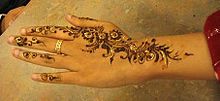 Mehndi is applied on women's hands at a Diwali Mela.
Mehndi is applied on women's hands at a Diwali Mela.
Among the many activities that take place at a mela are performances by jugglers, acrobats, snake charmers and fortune tellers. Food stalls are set up, selling sweet and spicy foods. There are a variety of rides at the fair, which include Ferris wheels and rides on animals such as elephants and camels. Activities for children, such as puppet shows, occur throughout the day.
In other parts of the world
Diwali is celebrated in various parts of the world, particularly those with large populations of Hindu and Sikh origin. These include countries such as Sri Lanka, Myanmar,[31] Thailand, Malaysia, Singapore, Indonesia, Australia, New Zealand, Fiji, Mauritius, Kenya, Tanzania, South Africa, Guyana, Surinam, Trinidad and Tobago, the Netherlands, Canada, the United Kingdom,[31] and the United States. With more and more Indians now migrating to various parts of the world, the number of countries where Diwali / Deepavali is celebrated has been gradually increasing. While in some countries it is celebrated mainly by Indian expatriates, in others it has become part of the general local culture. In most of these countries Diwali is celebrated on the same lines as described in this article with some minor variations. Some important variations are worth mentioning.
In Nepal, Diwali is known as "Tihar" or "Swanti". It is celebrated during the October/November period. Here the festival is celebrated for five days and the traditions vary from those followed in India. On the first day (Kaag tihar), crows are given offerings, considering them to be divine messengers. On the second day (Kukur tihar), dogs are given food for their honesty. On the third day, Laxmi puja is performed. This is the last day according to Nepal Sambat, so many of the businessmen clear their accounts on this day and on finishing it, worship goddess Laxmi, the goddess of wealth. The fourth day is celebrated as new year. Cultural processions and other celebrations are observed in this day. The Newars celebrate it as "Maha Puja", a special ritual in which the body is worshipped to keep it fit and healthy for the year ahead on this day. On the fifth and final day called "Bhai Tika", brothers and sisters meet and exchange gifts.
In Nepal, family gathering is more significant during Diwali. People in the community play "Deusi and Bhailo" which is a kind of singing and dancing forming a group. People go to all the houses in the community and play songs and dance, and give blessing to the visited house, whereas the home owner gives some food like rice grains, Roti, fruits and money. After the festival, people donate some part of collected money and food to the charity or welfare groups and rest of the money and food, they go for picnic. People also play swing called Dore Ping made out of thick ropes and Pirke Ping or Rangate Ping made out of woods.
In Sri Lanka, this festival is also called "Deepavali" and is celebrated by the Tamil community. On this day, it is traditional for people to take an oil bath in the morning, wear new clothes, exchange gifts, performing Poosai(Pūjā), and a visit to the Koil(Hindu Temple) is normal.[32] Burning of firecrackers in the evening of the festival is a common practice of this festival. Hindus light oil lamps to invite the blessings of Lakshmi, the goddess of wealth and to banish any evil from the household for once and for all.[33] The festival is marked by illumination, making of toys of enamel and making of figures out of crystal sugar popularly known as Misiri. Srilanka's celebration include many of the traditional aspects of Deepavali such as games, fireworks, singing and dancing, however the tradition of a large meal and fireworks are admirably preserved.
In Malaysia, Diwali festival is celebrated during the seventh month of the Hindu solar calendar. It is a federal public holiday throughout Malaysia. In many respects it resembles the traditions followed in the Indian subcontinent. 'Open houses' are held where Hindu Malaysians (Of all ethnic races like Tamils,Telugus and Malayalees) welcome fellow Malaysians of different races and religions to their house for a scrumptious meal. This is a practice unique to Malaysia and shows the goodwill and friendly ties practiced by all Malaysians during any festive occasion.
In Singapore, Diwali festival is a gazetted public holiday. Observed primarily by the minority Indian community (Tamils), it is typically marked by a light-up in the Little India district, the heart of the Indian community. Apart from the light-up, other activities such as bazaars, exhibitions, parades and concerts will also take place in Little India. The Hindu Endowment Board of Singapore along with Singapores' government organizes many of these cultural events during this festive period.
In Trinidad and Tobago, communities all over the islands get together and celebrate the festival. One major celebration that stands out is the Diwali Nagar, or Village of the Festival of Lights. It features stage performances by the east Indian cultural practitioners, a folk theatre featuring skits and plays, an exhibition on some aspect of Hinduism, displays by various Hindu religious sects and social organizations, nightly worship of Lakshmi, lighting of deeyas, performances by various schools related to Indian culture, and a food court with Indian and non-Indian vegetarian delicacies. The festival culminates with magnificent fireworks displays ushering in Diwali. Thousands of people participate in an atmosphere devoid of alcohol and in a true family environment.
In Britain, Hindus celebrate Diwali with great enthusiasm. People clean and decorate their homes with lamps and candles. A popular type of candle is a diya. People also give each other sweets such as laddoo and barfi, and the different communities may gather for a religious ceremony and get-together. It is also an important time to contact family in India and perhaps exchange gifts. Diwali is becoming well known in Britain and some non-Indians join in. Leicester plays hosts to some of the biggest celebrations outside of India.[34] Diwali also coincides with British Bonfire Night traditions on November the 5th. In the East End of London, a kind of joint festival has evolved where everyone enjoys the same fire and fireworks for their own diverse reasons.
In the United States, with increasing Indian population, Diwali is assuming significant importance year after year. Diwali was first celebrated in the White House in 2003 and was given official status by the United States Congress in 2007. Barack Obama became the first president to personally attend Diwali at the White House in 2009. On the eve of his first visit to India as the President of United States, Obama released an official statement sharing best wishes with "Hindus" for Diwali.[35] Indians in the US celebrate Diwali in different parts of the US, just as in India. The Diwali Mela in Cowboys Stadium boasted an attendance of 100,000 people in 2009. In 2009, San Antonio became the first U.S. city to sponsor an official Diwali celebration including a fireworks display and 5000 people in attendance.[citation needed] In 2011, The Pierre in New York City, now operated by Tata Group's Taj Hotels, hosted its first Diwali celebration.[36]
In Australia, Diwali is celebrated publicly among the people of Indian origin and the local Australians in Melbourne. On 21 July 2002 an organisation “The Australian Indian Innovations Incorporated” (AIII) consisting of a conglomerate of independent organisations and individuals was formed to celebrate Indian Festivals In Melbourne. AIII facilitated opportunities to depict the cultural kaleidoscope of India and assist Indians in Melbourne to showcase Indian art, culture, style, traditions and food via various activities, seminars, festivals, fairs and events. The first Inaugural Diwali Festival-2002”, was held at Sandown Race Course on Sunday 13 October 2002. Since then until October 2008, about 140000 people visited this Australian Indian Cultural Extravaganza filled with culture, fun and cuisine. This 10 Hour Festival is depicting India through 50 Stalls, 10 Food stalls and an 8 hour cultural programme with Dj, Children's rides and spectacular fire works over the last 7 years.
Other place where Diwali is celebrated in Melbourne is Sri Shiva Vishnu Temple, Carrum Downs. Food stalls are present and children fun rides. Later on in the evening a spectacular fireworks show is displayed.
In New Zealand, Diwali is celebrated publicly among many of the South Asian diaspora cultural groups. There are main public festivals in Auckland and Wellington, with other events around the country becoming more popular and visible. An official reception has been held at the New Zealand Parliament since 2003.[37] Divali is celebrated by Hindus. The festival signifies the triumph of light over darkness, justice over injustice, good over evil and intelligence over ignorance. Lakshmi Mata is worshipped at this festival. Lakshmi Mata is the goddess of light, wealth and beauty. Special Divali foods are barfi and Prasad.
Notes
- ^ The name of the festival in various regional languages include:
Sanskrit: दीपावली, Dīpāvalī ?, Tamil: தீபாவளி, Tīpāvaḷi ?, Nepali: दीपावली, तिहार, Dīpāvalī, Tihāra ?, Hindi: दिवाली, Divālī ?, Gujarati: દિવાળી, Divāḷī ?, Marathi: दिवाळी, Divāḷī ?, Kannada: ದೀಪಾವಳಿ, Dīpāvaḷi ?, Konkani: धाकली दिवाळी, Dhākalī Divāḷī ?, Malayalam: ദീപാവലി, Dīpāvali ?, Oriya: ଦୀପାବଳୀ, Dīpābaḷī ?, Punjabi: ਦਿਵਾਲੀ, Divālī ?, Telugu: దీపావళి, Dīpāvaḷi ?, Urdu: دیوالی, Dy̰wạly̰ ?
References
- ^ Parmita Borah (Oct 26, 2011). "Diwali - The Festival Of Lights". EF News International. http://www.efi-news.com/2011/10/diwali-festival-of-lights.html. Retrieved Oct 27 2011.
- ^ S.P. Sharma; Seema Gupta (2006). Fairs and Festivals of India. Pustak Mahal. p. 79. ISBN 9788122309515. http://books.google.com/?id=wPPr9HdmnHcC&pg=PA79&dq=diwali+mahavira+527.
- ^ a b Upadhye, A. N.; Upadhye, A. N. (Jan.-Mar. 1982). Cohen, Richard J.. ed. "Mahavira and His Teachings". Journal of the American Oriental Society (American Oriental Society) 102 (1): 231–232. doi:10.2307/601199. JSTOR 601199.
- ^ "Indian Government Holiday Calendar". National Portal of India. http://india.gov.in/calendar/calendar.php. Retrieved 15 March 2010.
- ^ YourSingapore.com - Deepavali
- ^ "Diwali Expands to World Festival":CNN[1]
- ^ Monier Monier-Williams. Sanskrit-English Dictionary. Entry for दीप. p. 481.
- ^ Zak Vera. Invisible River: Sir Richard's Last Mission. http://books.google.com/books?id=8HhVcspIBU4C&pg=PA179&dq=lamps+kept+on+diwali+lakshmi+evil+spirit&hl=en&ei=U2eoTq3kEsG5tgeIkLkJ&sa=X&oi=book_result&ct=result&resnum=1&ved=0CEsQ6AEwAA#v=onepage&q&f=false. Retrieved 26 October 2011. "First Diwali day called Dhanteras or wealth worship. We perform Laskshmi-Puja in evening when clay diyas lighted to drive away shadows of evil spirits."
- ^ Pramodkumar. Meri Khoj Ek Bharat Ki. http://books.google.com/books?id=6A9EZRQIT9kC&pg=PA109&dq=lamps+kept+on+diwali+lakshmi&hl=en&ei=-WWoTsHxHMOItwe45twV&sa=X&oi=book_result&ct=result&resnum=5&ved=0CGQQ6AEwBA#v=onepage&q&f=false. Retrieved 26 October 2011. "It is extremely important to keep the house spotlessly clean and pure on Diwali. Goddess Lakshmi likes cleanliness, and she will visit the cleanest house first. Lamps are lit in the evening to welcome the goddess. They are believed to light up her path."
- ^ Ruth Solski (2008). Big Book of Canadian Celebrations. S&S Learning Materials. http://books.google.com/books?id=ni2z5Z35htkC&pg=PA54&dq=lamps+diwali+evil+spirits&hl=en&ei=l2ioTsinEYigtwe5u9EO&sa=X&oi=book_result&ct=result&resnum=1&ved=0CE0Q6AEwAA#v=onepage&q=lamps%20diwali%20evil%20spirits&f=false. Retrieved 26 October 2011. "Fireworks and firecrackers are set off to chase away evil spirits, so it is a noisy holiday too."
- ^ Valerie Petrillo. Asian American History. Chicago Review Press. http://books.google.com/books?id=GErOyV7FBNUC&pg=PA175&dq=lamps+diwali+evil+spirits&hl=en&ei=l2ioTsinEYigtwe5u9EO&sa=X&oi=book_result&ct=result&resnum=2&ved=0CFIQ6AEwAQ#v=onepage&q=lamps%20diwali%20evil%20spirits&f=false. Retrieved 26 October 2011. "There are firecrackers everywhere to scare off evil spirits and contribute to the festive atmosphere."
- ^ David DeRocco, Joan Dundas, Ian Zimmerman. The International Holiday & Festival Primer. Full Blast Productions. http://books.google.com/books?id=TRyb8XqB7dEC&pg=SA9-PA1&dq=lamps+diwali+evil+spirits&hl=en&ei=l2ioTsinEYigtwe5u9EO&sa=X&oi=book_result&ct=result&resnum=3&ved=0CFcQ6AEwAg#v=onepage&q=lamps%20diwali%20evil%20spirits&f=false. Retrieved 26 October 2011. "But as well as delighting the spectators, the fireworks are believed to chase away evil spirits."
- ^ "Divali". http://www.mahavidya.ca/?page_id=80.
- ^ "Importance of various days of Deepavali". hindujagruti.org. http://www.hindujagruti.org/hinduism/festivals/diwali/details.php. Retrieved 2008-10-11.
- ^ "Dhanteras". http://www.diwalifestival.org/dhanteras.html.
- ^ Diwali History
- ^ Jacobi, Hermann (1884). Sacred Books of the East. 22: Gaina Sutras Part I.
- ^ Akademi, Sahitya (1988). Encyclopaedia of Indian literature. 2. ISBN 8126011947.
- ^ "Religions - Sikhism: Diwali". BBC. 2011-10-20. http://www.bbc.co.uk/religion/religions/sikhism/holydays/diwali.shtml. Retrieved 2011-10-25.
- ^ "Diwali Festival | Deepavali | Festival of Lights | Hindu Festival Diwali". itslife.in. http://www.itslife.in/2008/10/diwali-festival-significance-in-different-religions. Retrieved 2011-10-25.
- ^ "Nov 5th 2010 - India — Diwali, a significant festival in Hinduism, Sikhism, Buddhism, and Jainism. - Buddhachannel : le portail du bouddhisme dans le monde". Buddhachannel.tv. http://www.buddhachannel.tv/portail/spip.php?article3291. Retrieved 2011-10-25.
- ^ http://www.karmapa-news.org/index.php?id=350
- ^ "Diwali". Society for the Confluence of Festivals in India. http://www.diwalifestival.org/. Retrieved 25 October 2011.
- ^ "Diwali Festival of Light". BAPS Swaminarayan Sanstha. http://www.swaminarayan.org/festivals/diwali/. Retrieved 25 October 2011.
- ^ Diwali i Gujarat at diwalifestival.org
- ^ Historical studies in Kerala - M. G. S. Narayanan, K. K. N. Kurup, M. G. S. Narayanan ([2])
- ^ Census of India, 1961: Kerala p.134 http://books.google.com/books?id=jOEcAQAAMAAJ
- ^ "Diwali Celebrations & Traditions in Orissa - Diwali 2011 India: Diwali Festival, Diwali Celebrations India, Deepavali History". Diwaligifts2indians.com. 2008-10-14. http://www.diwaligifts2indians.com/2008/10/diwali-celebrations-traditions-in.html. Retrieved 2011-10-25.
- ^ Gajrani, S. (2004). History, religion & culture of India. 3. Gyan Publishing House. p. 109. ISBN 8182050626.
- ^ Kadowala, Dilip (1998). Diwali. London: Evans Brothers Limited. ISBN 0-237-51801-5.
- ^ a b "Diwali Celebrations Around The World". diwalifestival.org. http://www.diwalifestival.org/diwali-celebrations-around-the-world.html. Retrieved 2006-08-27.
- ^ In Sri Lanka, this festival is mostly celebrated by the Tamil community scattered in different areas of the island but mostly concentrated in the north.
- ^ http://www.asiarooms.com/en/travel-guide/sri-lanka/sri-lanka-festivals-&-events/deepavali-festival.html
- ^ "Diwali - The Festival of Light", Leicester website Leisure and Culture page.
- ^ White House press release, November 4, 2010.
- ^ "New York's Pierre Hotel Celebrates its First Diwali", The New York Times India blog, October 20, 2011. Retrieved 2011-10-20.
- ^ "Diwali Downunder: Transforming and Performing Indian Tradition in Aotearoa/New Zealand". New Zealand Journal of Media Studies 9 (1): 25–35. 2005. ISSN 0811 1173 0811. http://www.nzetc.org/tm/scholarly/tei-Sch091JMS-t1-g1-t5.html.
External links
- Diwali at the Open Directory Project
Festivals in the Hindu calendar Major festivals - Pongal (Makar Sankranti)
- Holi
- Rama Navami
- Krishna Janmashtami
- Maha Shivaratri
- Onam
- Ganesh Chaturthi
- Navratri (Mysore Dasara – Durga Puja – Vijayadashami)
- Diwali (Bhau-Beej)
- Chhath
- Vat Purnima

Regional New Year - Gudi Padwa (Marathi, Konkani)
- Ugadi (Telugu, Kannada)
- Cheti Chand (Sindhi)
- Bihu (Assamese)
- Vaisakhi (Punjabi)
- Vishuva Sankranti (Oriya)
- Pohela Boishakh (Bengali)
- Puthandu (Tamil)
- Vishu (Malayalee)
Holy days Holy periods
Wikimedia Foundation. 2010.

